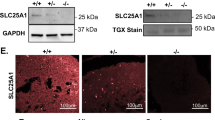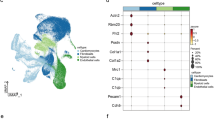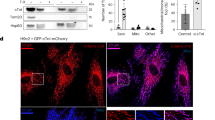Abstract
The mitochondrial phosphate carrier (PiC) is critical for ATP synthesis by serving as the primary means for mitochondrial phosphate import across the inner membrane. In addition to its role in energy production, PiC is hypothesized to have a role in cell death as either a component or a regulator of the mitochondrial permeability transition pore (MPTP) complex. Here, we have generated a mouse model with inducible and cardiac-specific deletion of the Slc25a3 gene (PiC protein). Loss of PiC protein did not prevent MPTP opening, suggesting it is not a direct pore-forming component of this complex. However, Slc25a3 deletion in the heart blunted MPTP opening in response to Ca2+ challenge and led to a greater Ca2+ uptake capacity. This desensitization of MPTP opening due to loss or reduction in PiC protein attenuated cardiac ischemic-reperfusion injury, as well as partially protected cells in culture from Ca2+ overload induced death. Intriguingly, deletion of the Slc25a3 gene from the heart long-term resulted in profound hypertrophy with ventricular dilation and depressed cardiac function, all features that reflect the cardiomyopathy observed in humans with mutations in SLC25A3. Together, these results demonstrate that although the PiC is not a direct component of the MPTP, it can regulate its activity, suggesting a novel therapeutic target for reducing necrotic cell death. In addition, mice lacking Slc25a3 in the heart serve as a novel model of metabolic, mitochondrial-driven cardiomyopathy.
Similar content being viewed by others
Log in or create a free account to read this content
Gain free access to this article, as well as selected content from this journal and more on nature.com
or
Abbreviations
- α-MHC:
-
α-myosin heavy chain
- AdCre:
-
adenovirus-expressing Cre recombinase
- Adβgal:
-
adenovirus-expressing β-galactosidase
- ANT:
-
adenine nucleotide translocator
- ATR:
-
atractyloside
- CypD:
-
cyclophilin D
- CsA:
-
cyclosporine A
- fl:
-
loxP site
- MCM:
-
αMHC-MerCreMer transgene
- MEFs:
-
mouse embryonic fibroblasts
- MPTP:
-
mitochondrial permeability transition pore
- Pi:
-
inorganic phosphate
- PiC:
-
mitochondrial phosphate carrier
- OXPHOS:
-
mitochondrial oxidative phosphorylation
- ROS:
-
reactive oxygen species
- SR:
-
sarcoplasmic reticulum
- WT:
-
wild type
References
Skladal D, Halliday J, Thorburn DR . Minimum birth prevalence of mitochondrial respiratory chain disorders in children. Brain 2003; 126: 1905–1912.
Vafai SB, Mootha VK . Mitochondrial disorders as windows into an ancient organelle. Nature 2012; 491: 374–383.
Zaragoza MV, Brandon MC, Diegoli M, Arbustini E, Wallace DC . Mitochondrial cardiomyopathies: how to identify candidate pathogenic mutations by mitochondrial DNA sequencing, MITOMASTER and phylogeny. Eur J Hum Genet 2011; 19: 200–207.
Brega A, Narula J, Arbustini E . Functional, structural, and genetic mitochondrial abnormalities in myocardial diseases. J Nucl Cardiol 2001; 8: 89–97.
DiMauro S, Hirano M . Mitochondria and heart disease. Curr Opin Cardiol 1998; 13: 190–197.
Kolbe HV, Costello D, Wong A, Lu RC, Wohlrab H . Mitochondrial phosphate transport. Large scale isolation and characterization of the phosphate transport protein from beef heart mitochondria. J Biol Chem 1984; 259: 9115–9120.
Palmieri F . The mitochondrial transporter family (SLC25): physiological and pathological implications. Pflugers Arch 2004; 447: 689–709.
Ko YH, Delannoy M, Hullihen J, Chiu W, Pedersen PL . Mitochondrial ATP synthasome. Cristae-enriched membranes and a multiwell detergent screening assay yield dispersed single complexes containing the ATP synthase and carriers for Pi and ADP/ATP. J Biol Chem 2003; 278: 12305–12309.
Chen C, Ko Y, Delannoy M, Ludtke SJ, Chiu W, Pedersen PL . Mitochondrial ATP synthasome: three-dimensional structure by electron microscopy of the ATP synthase in complex formation with carriers for Pi and ADP/ATP. J Biol Chem 2004; 279: 31761–31768.
Mayr JA, Zimmermann FA, Horvath R, Schneider HC, Schoser B, Holinski-Feder E et al. Deficiency of the mitochondrial phosphate carrier presenting as myopathy and cardiomyopathy in a family with three affected children. Neuromuscul Disord 2011; 21: 803–808.
Mayr JA, Merkel O, Kohlwein SD, Gebhardt BR, Bohles H, Fotschl U et al. Mitochondrial phosphate-carrier deficiency: a novel disorder of oxidative phosphorylation. Am J Hum Genet 2007; 80: 478–484.
Palmieri L, Alberio S, Pisano I, Lodi T, Meznaric-Petrusa M, Zidar J et al. Complete loss-of-function of the heart/muscle-specific adenine nucleotide translocator is associated with mitochondrial myopathy and cardiomyopathy. Hum Mol Genet 2005; 14: 3079–3088.
Graham BH, Waymire KG, Cottrell B, Trounce IA, MacGregor GR, Wallace DC . A mouse model for mitochondrial myopathy and cardiomyopathy resulting from a deficiency in the heart/muscle isoform of the adenine nucleotide translocator. Nat Genet 1997; 16: 226–234.
Alcala S, Klee M, Fernandez J, Fleischer A, Pimentel-Muinos FX . A high-throughput screening for mammalian cell death effectors identifies the mitochondrial phosphate carrier as a regulator of cytochrome c release. Oncogene 2008; 27: 44–54.
Halestrap AP . What is the mitochondrial permeability transition pore? J Mol Cell Cardiol 2009; 46: 821–831.
Leung AW, Varanyuwatana P, Halestrap AP . The mitochondrial phosphate carrier interacts with cyclophilin D and may play a key role in the permeability transition. J Biol Chem 2008; 283: 26312–26323.
Giorgio V, von Stockum S, Antoniel M, Fabbro A, Fogolari F, Forte M et al. Dimers of mitochondrial ATP synthase form the permeability transition pore. Proc Natl Acad Sci USA 2013; 110: 5887–5892.
Bonora M, Bononi A, De Marchi E, Giorgi C, Lebiedzinska M, Marchi S et al. Role of the c subunit of the FO ATP synthase in mitochondrial permeability transition. Cell Cycle 2013; 12: 674–683.
Baines CP, Kaiser RA, Purcell NH, Blair NS, Osinska H, Hambleton MA et al. Loss of cyclophilin D reveals a critical role for mitochondrial permeability transition in cell death. Nature 2005; 434: 658–662.
Nakagawa T, Shimizu S, Watanabe T, Yamaguchi O, Otsu K, Yamagata H et al. Cyclophilin D-dependent mitochondrial permeability transition regulates some necrotic but not apoptotic cell death. Nature 2005; 434: 652–658.
Kokoszka JE, Waymire KG, Levy SE, Sligh JE, Cai J, Jones DP et al. The ADP/ATP translocator is not essential for the mitochondrial permeability transition pore. Nature 2004; 427: 461–465.
Karch J, Kwong JQ, Burr AR, Sargent MA, Elrod JW, Peixoto PM et al. Bax and Bak function as the outer membrane component of the mitochondrial permeability pore in regulating necrotic cell death in mice. Elife 2013; 2: e00772.
Whelan RS, Konstantinidis K, Wei AC, Chen Y, Reyna DE, Jha S et al. Bax regulates primary necrosis through mitochondrial dynamics. Proc Natl Acad Sci USA 2012; 109: 6566–6571.
Beatrice MC, Palmer JW, Pfeiffer DR . The relationship between mitochondrial membrane permeability, membrane potential, and the retention of Ca2+ by mitochondria. J Biol Chem 1980; 255: 8663–8671.
Al-Nasser I, Crompton M . The reversible Ca2+-induced permeabilization of rat liver mitochondria. Biochem J 1986; 239: 19–29.
Crompton M, Costi A . Kinetic evidence for a heart mitochondrial pore activated by Ca2+, inorganic phosphate and oxidative stress. A potential mechanism for mitochondrial dysfunction during cellular Ca2+ overload. Eur J Biochem 1988; 178: 489–501.
Varanyuwatana P, Halestrap AP . The roles of phosphate and the phosphate carrier in the mitochondrial permeability transition pore. Mitochondrion 2012; 12: 120–125.
Gutierrez-Aguilar M, Perez-Martinez X, Chavez E, Uribe-Carvajal S . In Saccharomyces cerevisiae, the phosphate carrier is a component of the mitochondrial unselective channel. Arch Biochem Biophys 2010; 494: 184–191.
Lehninger AL . Role of phosphate and other proton-donating anions in respiration-coupled transport of Ca2+ by mitochondria. Proc Natl Acad Sci USA 1974; 71: 1520–1524.
Lehninger AL, Carafoli E, Rossi CS . Energy-linked ion movements in mitochondrial systems. Adv Enzymol Relat Areas Mol Biol 1967; 29: 259–320.
Narula N, Zaragoza MV, Sengupta PP, Li P, Haider N, Verjans J et al. Adenine nucleotide translocase 1 deficiency results in dilated cardiomyopathy with defects in myocardial mechanics, histopathological alterations, and activation of apoptosis. JACC Cardiovasc Imaging 2011; 4: 1–10.
Sohal DS, Nghiem M, Crackower MA, Witt SA, Kimball TR, Tymitz KM et al. Temporally regulated and tissue-specific gene manipulations in the adult and embryonic heart using a tamoxifen-inducible Cre protein. Circ Res 2001; 89: 20–25.
Nakayama H, Bodi I, Correll RN, Chen X, Lorenz J, Houser SR et al. alpha1G-dependent T-type Ca2+ current antagonizes cardiac hypertrophy through a NOS3-dependent mechanism in mice. J Clin Invest 2009; 119: 3787–3796.
Kaiser RA, Bueno OF, Lips DJ, Doevendans PA, Jones F, Kimball TF et al. Targeted inhibition of p38 mitogen-activated protein kinase antagonizes cardiac injury and cell death following ischemia-reperfusion in vivo. J Biol Chem 2004; 279: 15524–15530.
Goonasekera SA, Hammer K, Auger-Messier M, Bodi I, Chen X, Zhang H et al. Decreased cardiac L-type Ca(2)(+) channel activity induces hypertrophy and heart failure in mice. J Clin Invest 2012; 122: 280–290.
Maillet M, Davis J, Auger-Messier M, York A, Osinska H, Piquereau J et al. Heart-specific deletion of CnB1 reveals multiple mechanisms whereby calcineurin regulates cardiac growth and function. J Biol Chem 2010; 285: 6716–6724.
Bassani RA, Bassani JW, Bers DM . Mitochondrial and sarcolemmal Ca2+ transport reduce [Ca2+]i during caffeine contractures in rabbit cardiac myocytes. J Physiol 1992; 453: 591–608.
Paradies G, Ruggiero FM . Effect of aging on the activity of the phosphate carrier and on the lipid composition in rat liver mitochondria. Arch Biochem Biophys 1991; 284: 332–337.
Vives-Bauza C, Yang L, Manfredi G . Assay of mitochondrial ATP synthesis in animal cells and tissues. Methods Cell Biol 2007; 80: 155–171.
Kwong JQ, Henning MS, Starkov AA, Manfredi G . The mitochondrial respiratory chain is a modulator of apoptosis. J Cell Biol 2007; 179: 1163–1177.
Tang S, Le PK, Tse S, Wallace DC, Huang T . Heterozygous mutation of Opa1 in Drosophila shortens lifespan mediated through increased reactive oxygen species production. PLoS One 2009; 4: e4492.
Starkov AA . Measurement of mitochondrial ROS production. Methods Mol Biol 2010; 648: 245–255.
King MP, Attardi G . Human cells lacking mtDNA: repopulation with exogenous mitochondria by complementation. Science 1989; 246: 500–503.
Spandidos A, Wang X, Wang H, Seed B . PrimerBank: a resource of human and mouse PCR primer pairs for gene expression detection and quantification. Nucleic Acids Res 2010; 38: D792–D799.
Acknowledgements
This work was supported by grants from the National Institutes of Health and the Howard Hughes Medical Institute (to JDM). JQK was supported by an American Heart Association postdoctoral fellowship from the Great Rivers Affiliate.
Author information
Authors and Affiliations
Corresponding author
Ethics declarations
Competing interests
The authors declare no conflict of interest.
Additional information
Edited by N Chandel
Supplementary Information accompanies this paper on Cell Death and Differentiation website
Supplementary information
Rights and permissions
About this article
Cite this article
Kwong, J., Davis, J., Baines, C. et al. Genetic deletion of the mitochondrial phosphate carrier desensitizes the mitochondrial permeability transition pore and causes cardiomyopathy. Cell Death Differ 21, 1209–1217 (2014). https://doi.org/10.1038/cdd.2014.36
Received:
Revised:
Accepted:
Published:
Issue date:
DOI: https://doi.org/10.1038/cdd.2014.36
This article is cited by
-
Inhibition of mitochondrial phosphate carrier prevents high phosphate-induced superoxide generation and vascular calcification
Experimental & Molecular Medicine (2023)
-
Identity, structure, and function of the mitochondrial permeability transition pore: controversies, consensus, recent advances, and future directions
Cell Death & Differentiation (2023)
-
The role and mechanisms of microvascular damage in the ischemic myocardium
Cellular and Molecular Life Sciences (2023)
-
Mitochondrial Fission Process 1 controls inner membrane integrity and protects against heart failure
Nature Communications (2022)
-
Mitochondrial Drp1 recognizes and induces excessive mPTP opening after hypoxia through BAX-PiC and LRRK2-HK2
Cell Death & Disease (2021)



